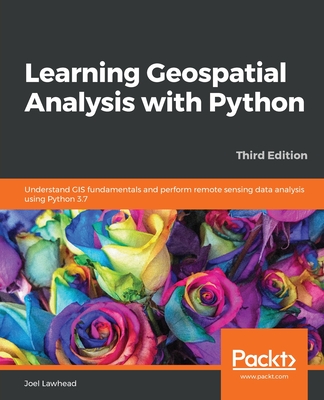Python GeoSpatial Analysis Essentials
暫譯: Python 地理空間分析必備知識
Erik Westra
- 出版商: Packt Publishing
- 出版日期: 2015-06-25
- 售價: $1,500
- 貴賓價: 9.5 折 $1,425
- 語言: 英文
- 頁數: 180
- 裝訂: Paperback
- ISBN: 1782174516
- ISBN-13: 9781782174516
-
相關分類:
Python
海外代購書籍(需單獨結帳)
買這商品的人也買了...
-
 Arduino Nano 3.0 with ATMEGA328
Arduino Nano 3.0 with ATMEGA328$350$333 -
 設計模式的解析與活用 (Design Patterns Explained: A New Perspective on Object-Oriented Design, 2/e)
設計模式的解析與活用 (Design Patterns Explained: A New Perspective on Object-Oriented Design, 2/e)$480$374 -
 $534利用 Python 進行數據分析 (Python for Data Analysis)
$534利用 Python 進行數據分析 (Python for Data Analysis) -
 AngularJS 建置與執行 (AngularJS: Up and Running: Enhanced Productivity with Structured Web Apps)
AngularJS 建置與執行 (AngularJS: Up and Running: Enhanced Productivity with Structured Web Apps)$520$411 -
 Python 設計模式深入解析 (Mastering Python Design Patterns)
Python 設計模式深入解析 (Mastering Python Design Patterns)$360$281 -
 精通 Python|運用簡單的套件進行現代運算 (Introducing Python: Modern Computing in Simple Packages)
精通 Python|運用簡單的套件進行現代運算 (Introducing Python: Modern Computing in Simple Packages)$780$616 -
 黑帽 Python | 給駭客與滲透測試者的 Python 開發指南 (Black Hat Python: Python Programming for Hackers and Pentesters)
黑帽 Python | 給駭客與滲透測試者的 Python 開發指南 (Black Hat Python: Python Programming for Hackers and Pentesters)$400$316 -
 $305圖解機器學習
$305圖解機器學習 -
 $449機器學習算法原理與編程實踐
$449機器學習算法原理與編程實踐 -
 流暢的 Python|清晰、簡潔、有效的程式設計 (Fluent Python)
流暢的 Python|清晰、簡潔、有效的程式設計 (Fluent Python)$980$774 -
 $354Selenium 2自動化測試實戰—基於 Python 語言
$354Selenium 2自動化測試實戰—基於 Python 語言 -
 $293Python 資料分析 (Python Data Analysis)
$293Python 資料分析 (Python Data Analysis) -
 $594Python 金融大數據分析 (Python for Finance)
$594Python 金融大數據分析 (Python for Finance) -
 $414Python 資料分析與挖掘實戰
$414Python 資料分析與挖掘實戰 -
 機器學習
機器學習$648$616 -
 $1,568Automating Junos Administration: Doing More with Less(Paperback)
$1,568Automating Junos Administration: Doing More with Less(Paperback) -
 $450Python 絕技:運用 Python 成為頂級駭客 (Violent Python : A Cookbook for Hacker, Forensic Analysis, Penetration Testers and Security Engineers)
$450Python 絕技:運用 Python 成為頂級駭客 (Violent Python : A Cookbook for Hacker, Forensic Analysis, Penetration Testers and Security Engineers) -
 $294鳳凰計畫:一個 IT計畫的傳奇故事 (The Phoenix Project : A Novel about IT, DevOps, and Helping your business win)(沙盤特別版)
$294鳳凰計畫:一個 IT計畫的傳奇故事 (The Phoenix Project : A Novel about IT, DevOps, and Helping your business win)(沙盤特別版) -
 測試驅動開發:使用 Python (Test-Driven Development with Python)
測試驅動開發:使用 Python (Test-Driven Development with Python)$880$695 -
 React Native 學習手冊 (Learning React Native: Building Native Mobile Apps with JavaScript)
React Native 學習手冊 (Learning React Native: Building Native Mobile Apps with JavaScript)$580$458 -
 使用者故事對照 (User Story Mapping: Discover the Whole Story, Build the Right Product)
使用者故事對照 (User Story Mapping: Discover the Whole Story, Build the Right Product)$580$458 -
 資料科學的商業運用 (Data science for business)
資料科學的商業運用 (Data science for business)$680$537 -
 Python 程式設計實務-從初學到活用 Python 開發技巧的16堂課
Python 程式設計實務-從初學到活用 Python 開發技巧的16堂課$560$437 -
 Python 3 物件導向程式設計, 2/e
Python 3 物件導向程式設計, 2/e$480$379 -
 超圖解物聯網 IoT 實作入門 - 使用 JavaScript/Node.JS/Arduino/Raspberry
超圖解物聯網 IoT 實作入門 - 使用 JavaScript/Node.JS/Arduino/Raspberry$699$552
商品描述
Process, analyze, and display geospatial data using Python libraries and related tools
About This Book
- Learn to build a complete geospatial application from scratch using Python
- Create good-looking maps based on the results of your analysis
- This is a fast-paced guide to help you explore the key concepts of geospatial to obtain high quality spatial data
Who This Book Is For
If you are an experienced Python developer and wish to get up-to-speed with geospatial programming, then this book is for you. While familiarity with installing third-party Python libraries would be an advantage, no prior knowledge of geospatial programming is required.
What You Will Learn
- Understand the key geospatial concepts and techniques needed to analyze and work with geospatial data
- Learn how to read and write geospatial data from within your Python code
- Use PostGIS to store spatial data and perform spatial queries
- Use Python libraries to analyze and manipulate geospatial data
- Generate maps based on your spatial data
- Implement complete geospatial analysis systems using Python
- Use the Shapely and NetworkX libraries to solve problems such as distance-area calculations, finding the shortest path between two points, buffering polygons, and much more
In Detail
Python is a highly expressive language that makes it easy to write sophisticated programs. Combining high-quality geospatial data with Python geospatial libraries will give you a powerful toolkit for solving a range of geospatial programming tasks.
The book begins with an introduction to geospatial analysis and programming and explains the ideas behind geospatial data. You will explore Python libraries for building your own geospatial applications. You will learn to create a geospatial database for your application using PostGIS and the psycopg2 library, and see how the Mapnik library can be used to create attractive and useful maps.
Finally, you will learn to use the Shapely and NetworkX libraries to create, analyze, and manipulate complex geometric objects, before implementing a system to match GPS recordings against a database of roads to produce a heatmap of the most frequently used roads.
商品描述(中文翻譯)
**處理、分析和顯示地理空間數據,使用 Python 函式庫和相關工具**
## 本書介紹
- 學習如何從零開始使用 Python 建立完整的地理空間應用程式
- 根據分析結果創建美觀的地圖
- 這是一本快速入門指南,幫助您探索地理空間的關鍵概念,以獲得高品質的空間數據
## 本書適合誰
如果您是一位有經驗的 Python 開發者,並希望快速掌握地理空間編程,那麼這本書適合您。雖然熟悉安裝第三方 Python 函式庫會是一個優勢,但不需要具備地理空間編程的先前知識。
## 您將學到什麼
- 理解分析和處理地理空間數據所需的關鍵地理空間概念和技術
- 學習如何在 Python 代碼中讀取和寫入地理空間數據
- 使用 PostGIS 存儲空間數據並執行空間查詢
- 使用 Python 函式庫分析和操作地理空間數據
- 根據您的空間數據生成地圖
- 使用 Python 實現完整的地理空間分析系統
- 使用 Shapely 和 NetworkX 函式庫解決問題,例如距離-面積計算、尋找兩點之間的最短路徑、緩衝多邊形等
## 詳細內容
Python 是一種表達力強的語言,使得編寫複雜的程式變得容易。將高品質的地理空間數據與 Python 地理空間函式庫結合,將為您提供一個強大的工具包,以解決各種地理空間編程任務。
本書首先介紹地理空間分析和編程,並解釋地理空間數據背後的理念。您將探索用於構建自己地理空間應用程式的 Python 函式庫。您將學習如何使用 PostGIS 和 psycopg2 函式庫為您的應用程式創建地理空間數據庫,並了解如何使用 Mapnik 函式庫創建吸引人且實用的地圖。
最後,您將學習使用 Shapely 和 NetworkX 函式庫來創建、分析和操作複雜的幾何物件,然後實現一個系統,將 GPS 記錄與道路數據庫進行匹配,以生成最常使用道路的熱圖。






























